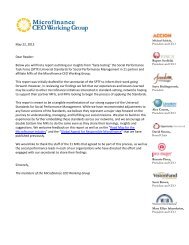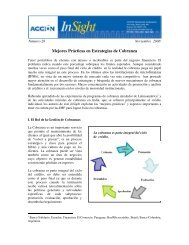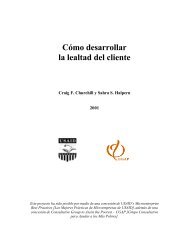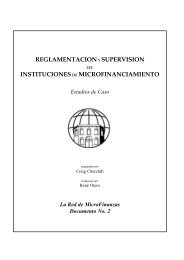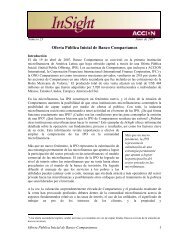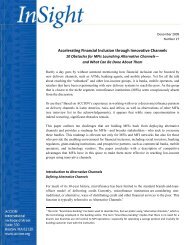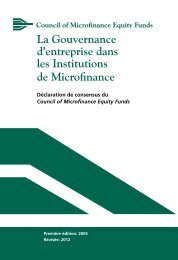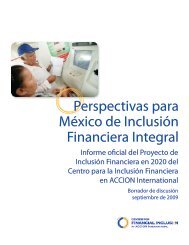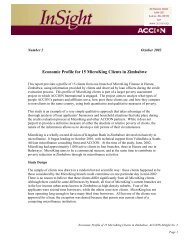Microfinance and Capital Markets - Council of Microfinance Equity ...
Microfinance and Capital Markets - Council of Microfinance Equity ...
Microfinance and Capital Markets - Council of Microfinance Equity ...
Create successful ePaper yourself
Turn your PDF publications into a flip-book with our unique Google optimized e-Paper software.
Ownership incentivesIn two <strong>of</strong> the institutions that listed—<strong>Equity</strong> Bank <strong>and</strong> Compartamos—management <strong>and</strong>director ownership has become an important issue. It st<strong>and</strong>s to reason that long-servingmanagement <strong>and</strong> directors should have incentives tied closely to the long-range success<strong>of</strong> their institution. The fact that these individuals have been rewarded for their success isa good signal to the industry in general <strong>and</strong> should also enable the industry to attract firstclasstalent as the very critical issue <strong>of</strong> management succession is addressed in a number<strong>of</strong> MFIs. In both <strong>of</strong> these cases, management acquired their shares through investment.However, as public entities they will be able to use incentives such as options or stockgrants as incentives for existing management <strong>and</strong> employees <strong>and</strong>, as appropriate, toattract new management into the company.Many MFIs have operated with the same senior management team over the last 15–20years or more, from the early emergence <strong>of</strong> micr<strong>of</strong>inance in the developing world.Incentive compensation could play an important role in an orderly succession both out <strong>of</strong><strong>and</strong> into these institutions. That is the normal case in for-pr<strong>of</strong>it institutions, both financial<strong>and</strong> industrial. BRI, with majority ownership by the Indonesian government, couldpresumably not <strong>of</strong>fer such incentives. In the case <strong>of</strong> BRAC Bank, the very smallownership stake <strong>of</strong> the senior management <strong>of</strong> the NGO speaks highly <strong>of</strong> their individualcommitments to the Bangladeshi poor.Despite these two examples, incentives have an important role to play as MFIs structurethemselves on commercial terms <strong>and</strong> become shareholder-owned institutions. We wouldexpect to see stock options as an important form <strong>of</strong> incentive compensation formanagement recruitment <strong>and</strong> employee stock plans as more MFIs go public in the future.ScaleEach <strong>of</strong> these institutions has achieved massive scale within its respective market,translating into a strong capital base <strong>and</strong> pr<strong>of</strong>its. As banks by any international measure,the four are quite small, but within their markets BRI <strong>and</strong> <strong>Equity</strong> Bank are important.BRAC has also reached substantial scale, especially if we look at the combinedmicr<strong>of</strong>inance <strong>and</strong> SME operations (the latter within BRAC Bank). Compartamos is aniche bank in Mexico, but it is among the largest MFIs in the country <strong>and</strong> Latin America.The pr<strong>of</strong>itability, return on assets, return on equity <strong>and</strong> low loan-loss ratios <strong>of</strong> theseinstitutions rank them among the best performing banks <strong>and</strong> financial institutions in theirrespective markets. Clearly these four institutions are among the best <strong>of</strong> the MFIs. Assuch they were able to list <strong>and</strong> issue their shares to both domestic <strong>and</strong> internationalinvestors. The performance to date <strong>of</strong> their post-IPO stocks is a reflection <strong>of</strong> their longtermgrowth potential. Even if we assume that their growth rate will slow by 50% by theend <strong>of</strong> 2011, collectively their scale or outreach to the working poor is very significant—projected at some 11 million borrowers <strong>and</strong> 41 million savers. 5454 Projections prepared by Bruce Campbell take the historical growth rate <strong>of</strong> each <strong>of</strong> the institutionscompared to the number <strong>of</strong> borrowers <strong>and</strong> then reduce their rate <strong>of</strong> growth stepwise between 2007–2011 sothat by the end <strong>of</strong> 2011 the growth rate has been reduced by 50%. For savings, the projections focus onlyon <strong>Equity</strong> Bank <strong>and</strong> BRI. At present BRI dominates these numbers. However, Compartamos is beginningto experiment with savings, <strong>and</strong> BRAC is mobilizing a large amount <strong>of</strong> savings in its SME bank. Were both22



